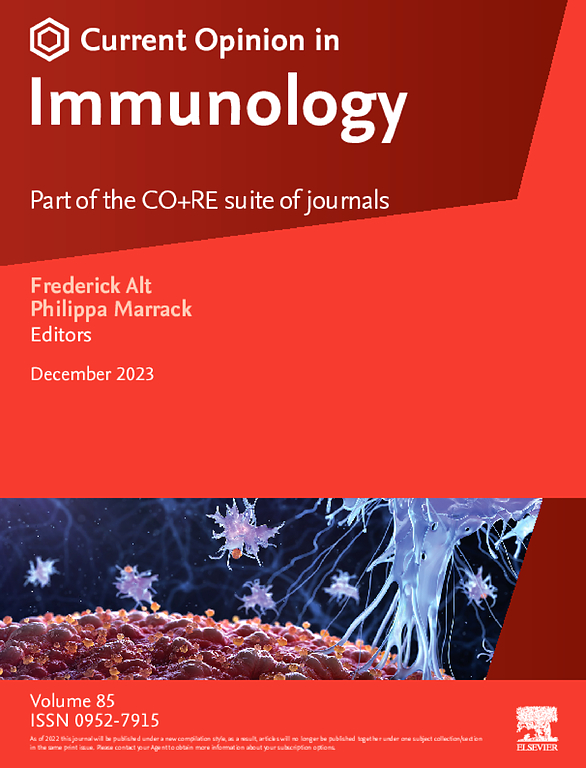Mechanobiology of neutrophil inflammasome signaling in psoriasis
IF 5.8
2区 医学
Q1 IMMUNOLOGY
引用次数: 0
Abstract
While T cells play a prominent role, polymorphonuclear neutrophils (PMN) are also significant players in the pathogenesis of psoriasis. This review details the mechanobiology of PMN in the amplification of skin inflammation, a process often under-scrutinized compared to T cell pathways. PMN surveillance of skin microcirculation involves selectin-mediated rolling that transitions to stable β2-integrin–mediated arrest. Upon tissue recruitment, PMN trigger the NLRP3 inflammasome and NETosis, releasing neutrophil extracellular traps, proinflammatory cytokines including IL-1β and IL-18, and damage-associated molecular patterns. These mediators promote keratinocyte proliferation and recruit additional waves of PMN that contribute to a positive feedback loop that sustains skin inflammation and hyperproliferation of keratinocytes. Consequently, assays measuring PMN activation provide a sensitive biomarker for the progression of psoriatic disease. Furthermore, therapeutically targeting upstream mechanosignaling pathways presents a novel therapeutic avenue to move beyond conventional strategies that block downstream cytokines critical for immunocompetence.
银屑病中性粒细胞炎性体信号传导的机制生物学研究。
T细胞在银屑病发病机制中起着重要作用,多形核中性粒细胞(PMN)在银屑病发病机制中也起着重要作用。这篇综述详细介绍了PMN在皮肤炎症放大中的机制生物学,与T细胞途径相比,这一过程经常被忽视。皮肤微循环的PMN监测涉及选择素介导的滚动,过渡到稳定的β2整合素介导的停止。在组织募集时,PMN触发NLRP3炎性体和NETosis,释放中性粒细胞胞外陷阱,促炎细胞因子包括IL-1β和IL-18,以及损伤相关的分子模式。这些介质促进角质形成细胞增殖并募集额外的PMN波,这有助于维持皮肤炎症和角质形成细胞过度增殖的正反馈循环。因此,检测PMN激活为银屑病的进展提供了一个敏感的生物标志物。此外,针对上游机械信号通路的治疗提供了一种新的治疗途径,超越了阻断对免疫能力至关重要的下游细胞因子的传统策略。
本文章由计算机程序翻译,如有差异,请以英文原文为准。
求助全文
约1分钟内获得全文
求助全文
来源期刊
CiteScore
13.30
自引率
1.40%
发文量
94
审稿时长
67 days
期刊介绍:
Current Opinion in Immunology aims to stimulate scientifically grounded, interdisciplinary, multi-scale debate and exchange of ideas. It contains polished, concise and timely reviews and opinions, with particular emphasis on those articles published in the past two years. In addition to describing recent trends, the authors are encouraged to give their subjective opinion of the topics discussed.
In Current Opinion in Immunology we help the reader by providing in a systematic manner: 1. The views of experts on current advances in their field in a clear and readable form. 2. Evaluations of the most interesting papers, annotated by experts, from the great wealth of original publications.
Current Opinion in Immunology will serve as an invaluable source of information for researchers, lecturers, teachers, professionals, policy makers and students.
Current Opinion in Immunology builds on Elsevier''s reputation for excellence in scientific publishing and long-standing commitment to communicating reproducible biomedical research targeted at improving human health. It is a companion to the new Gold Open Access journal Current Research in Immunology and is part of the Current Opinion and Research(CO+RE) suite of journals. All CO+RE journals leverage the Current Opinion legacy-of editorial excellence, high-impact, and global reach-to ensure they are a widely read resource that is integral to scientists'' workflow.

 求助内容:
求助内容: 应助结果提醒方式:
应助结果提醒方式:


